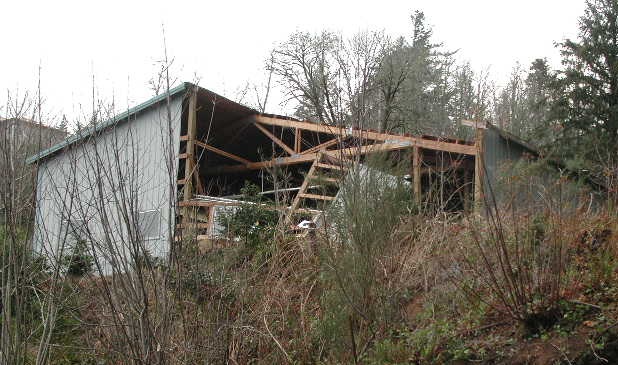Clatsop County’s Natural Hazards
Each of Clatsop County’s communities is subject to some or all of nine natural
hazards: windstorms and severe winter storms, coastal erosion, flood, landslide, earthquake, tsunami,
drought and volcanic activity.

Windstorms & Severe Winter Storms
| High Risk
Destructive wind
and winter storms that produce ice, rain and freezing rain, and high winds have a long history in Clatsop
County. Severe storms affecting Oregon with snow and ice typically originate in the Gulf of Alaska or in
the central Pacific Ocean. These storms are most common from October through March. Destructive windstorms
are less frequent, and their pattern is fairly well known. They form over the North Pacific during the
cool months (October through March), move along the coast and swing inland in a northeasterly direction.
Wind speeds vary with the storms. Gusts exceeding 100 miles per hour have been recorded at several coastal
locations.
Coastal Erosion | High Risk
Coastal erosion is a natural process that continually
affects the entire coast. Erosion becomes a hazard when human development, life and safety are threatened.
Coastal erosion processes create special challenges for people living near the ocean, requiring sound
planning in order to minimize the potential dangers to life and property. Attempts to stabilize the
shoreline or beach are often futile because the forces that shape the coast are persistent and powerful.
Inadequate understanding of the complex interaction of coastal land forms and waters and the various types
of coastal erosion can result in serious threats to people, communities and infrastructure.
Flood | High Risk
Oregon has
a detailed history of flooding with flood records dating back to the 1860s. The principal types of
flood that occur in Clatsop County include: (1) riverine and (2) ocean flooding from high tides and
wind-driven waves or tsunami event. There are two distinct periods of riverine flooding in this
region, winter and late spring. The most serious flooding occurs during December, January, and
February. The situation is especially severe when riverine flooding, caused by prolonged rain and
melting snow, coincides with high tides and coastal storm surges.

Landslide | High Risk
Landslides are a major geologic threat in almost every state in the
United States. In Oregon, a significant number of
locations are at risk from dangerous landslides and debris flows. While not all landslides
result in property damage, many landslides do pose serious risk to people and property.
Rain-induced landslides and debris flows can potentially occur during any winter in Clatsop
County.
Earthquake | High Risk
Seismic events were once thought to pose little or no threat to
Oregon communities. However, recent earthquakes and scientific evidence indicate that the
risk to people and property is much greater than previously thought. Oregon is rated third
highest in the nation for potential losses due to earthquakes. This is due in part to the
fact that until recently Oregon was not considered to be an area of high seismicity, and
consequently the majority of buildings and infrastructure were not designed to withstand the
magnitude of ground shaking that would occur in conjunction with a major seismic
occurrence.
Tsunami | Medium Risk
Tsunamis have historically been rare in Oregon. Since 1812, Oregon
has experienced about a dozen tsunamis with wave heights greater than 3 feet; some of these
were destructive. The City of Seaside is the most vulnerable city due to its low elevation
and high number of residents and tourist population within the predicted inundation zone.
Although many communities have evacuation maps and evacuation plans, many casualties are
expected. The built environment in the inundation zone will be especially hard hit.
Drought | Medium Risk
Droughts are not uncommon in the State of
Oregon, nor are they just an “east of the mountains” phenomenon. They occur in all parts of the
state, in both summer and winter. There are no records of a severe drought in Clatsop County.
Drought is averted as a result of the County’s high rainfall from moist air masses moving onto land
from the Pacific Ocean, especially during winter months.
Volcanic Debris | Low
Risk
The Cascade Range of the Pacific Northwest has more than a dozen active
volcanoes. These snow-clad peaks are part of a 1,000 mile-long chain of mountains, which extend
from southern British Columbia to northern California. Although there are no active volcanoes in
Clatsop County it is important for counties to know the potential impacts of nearby volcanoes.
While immediate danger area around a volcano is approximately 20 miles, ash fall problems may occur
as much as 100 miles or more from a volcano’s location; therefore, ash fall may affect Clatsop
County. Wildfire: Fire is an essential part of Oregon’s ecosystem, but it is also a serious threat
to life and property particularly in the state’s growing rural communities. Wildfires are fires
occurring in areas having large areas of flammable vegetation that require a suppression response.
Areas of wildfire risk exist throughout the state with areas in central, southwest and northeast
Oregon having the highest risk.
Adapted from
the Clatsop County Multi-Jurisdictional Natural Hazards Mitigation
Plan (Dated 03/08/2021)